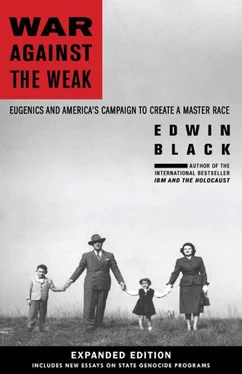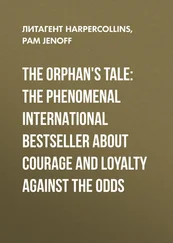Edwin Black - War Against the Weak
Здесь есть возможность читать онлайн «Edwin Black - War Against the Weak» весь текст электронной книги совершенно бесплатно (целиком полную версию без сокращений). В некоторых случаях можно слушать аудио, скачать через торрент в формате fb2 и присутствует краткое содержание. Город: Washington, DC, Год выпуска: 2012, ISBN: 2012, Издательство: Dialog Press, Жанр: История, на английском языке. Описание произведения, (предисловие) а так же отзывы посетителей доступны на портале библиотеки ЛибКат.
- Название:War Against the Weak
- Автор:
- Издательство:Dialog Press
- Жанр:
- Год:2012
- Город:Washington, DC
- ISBN:1-56858-258-7
- Рейтинг книги:3 / 5. Голосов: 2
-
Избранное:Добавить в избранное
- Отзывы:
-
Ваша оценка:
- 60
- 1
- 2
- 3
- 4
- 5
War Against the Weak: краткое содержание, описание и аннотация
Предлагаем к чтению аннотацию, описание, краткое содержание или предисловие (зависит от того, что написал сам автор книги «War Against the Weak»). Если вы не нашли необходимую информацию о книге — напишите в комментариях, мы постараемся отыскать её.
War Against the Weak — читать онлайн бесплатно полную книгу (весь текст) целиком
Ниже представлен текст книги, разбитый по страницам. Система сохранения места последней прочитанной страницы, позволяет с удобством читать онлайн бесплатно книгу «War Against the Weak», без необходимости каждый раз заново искать на чём Вы остановились. Поставьте закладку, и сможете в любой момент перейти на страницу, на которой закончили чтение.
Интервал:
Закладка:
Buck vividly recounted the day he was sterilized at Lynchburg. He was fifteen years old. “The call came over the dormitory just like always, and I knew they were ready for me,” he remembered. “There was no use fighting it. They gave me some pills that made me drowsy and then they wheeled me up to the operating room.” The doctor wielding the scalpel was Lynchburg Superintendent Dr. D. L. Harrell Jr., “who was like a father to me,” continued Buck. Dr. Harrell muttered, “Buck, I’m going to have to tie your tubes and then maybe you’ll be able to go home.” Drowsy, but awake, Buck witnessed the entire procedure. Dr. Harrell pinched Buck’s scrotum, made a small incision and then deftly sliced the sperm ducts, rendering Buck sterile. “I watched the whole thing. I was awake the whole time,” Buck recalled. 9
Buck Smith was sterilized because the state declared that as a feeble-minded individual, he was fundamentally incapable of caring for himself. Virginia authorities feared that if Buck were permitted to reproduce, his offspring would inherit immutable genetic traits for poverty and low intelligence. Poverty, or “pauperism,” as it was called at the time, was scientifically held by many esteemed doctors and universities to be a genetic defect, transmitted from generation to generation. Buck Smith was hardly feebleminded, and he spoke with simple eloquence about his mentality. “I’ve worked eleven years at the same job,” he said, “and haven’t missed more than three days of work. There’s nothing wrong with me except my lack of education.” 10
“I’ll never understand why they sterilized me,” Buck Smith disconso-lately told the local reporter. “I’ll never understand that. They [Lynchburg] gave me what life I have and they took a lot of my life away from me. Having children is supposed to be part of the human race.” 11
The reporter noticed a small greeting card behind Buck Smith. The sterilized man had eventually married and formed a lasting bond with his stepchildren. The card was from those stepchildren and read: “Thinking of you, Daddy.” Through tears, Buck Smith acknowledged the card, “They call me Daddy.” 12
Mary Donald was equally pained when she recalled her years of anguish following her sterilization at Lynchburg when she was only eleven. Several years later, she was “released” to her husband-to-be, and then enjoyed a good marriage for eighteen years. But “he loved kids,” she remembered. “I lay in bed and cried because I couldn’t give him a son,” she recounted in her heavily accented but articulate mountain drawl. “You know, men want a son to carry on their name. He said it didn’t matter. But as years went by, he changed. We got divorced and he married someone else.” With these words, Mary broke down and wept. 13
Like so many, Mary never understood what was happening. She recalled the day doctors told her. “They ask me, ‘Do you know what this meeting is for?’ I said, ‘No, sir, I don’t.’ ‘Well this is a meeting you go through when you have to have a serious operation, and it’s for your health.’ That’s the way they expressed it. ‘Well,’ I said, ‘if it’s for my health, then I guess I’ll go through with it.’ See, I didn’t know any difference.” Mary didn’t learn she had been sterilized until five years after her operation. 14
The surgeon’s blade cut widely. Sometimes the victims were simply tru-ants, petty thieves or just unattended boys captured by the sheriffs before they could escape. Marauding county welfare officials, backed by deputies, would take the youngsters into custody, and before long the boys would be shipped to a home for the feebleminded. Many were forced into virtual slave labor, sometimes being paid as little as a quarter for a full week of contract labor. Runaways and the recalcitrant were subject to beatings and torturous ninety-day stints in a darkened “blind room.” Their release was generally conditional on family acquiescence to their sterilization. 15
Mary Donald, “Buck Smith,” the brothers from Brush Mountain and many more whose names have long been forgotten are among the more than eight thousand Virginians sterilized as a result of coercion, stealth and deception in a wide-ranging program to prevent unwanted social, racial and ethnic groups from propagating. But the agony perpetrated against these people was hardly a local story of medical abuse. It did not end at the Virginia state line. Virginia’s victims were among some sixty thousand who were forcibly sterilized all across the United States, almost half of them in California. 16
Moreover, the story of America’s reproductive persecution constitutes far more than just a protracted medical travesty. These simple Virginia people, who thought they were isolated victims, plucked from their remote mountain homes and urban slums, were actually part of a grandiose, decades-long American movement of social and biological cleansing determined to obliterate individuals and families deemed inferior. The intent was to create a new and superior mankind.
The movement was called eugenics. It was conceived at the onset of the twentieth century and implemented by America’s wealthiest, most powerful and most learned men against the nation’s most vulnerable and helpless. Eugenicists sought to methodically terminate all the racial and ethnic groups, and social classes, they disliked or feared. It was nothing less than America’s legalized campaign to breed a super race-and not just any super race. Eugenicists wanted a purely Germanic and Nordic super race, enjoying biological dominion over all others. 17
Nor was America’s crusade a mere domestic crime. Using the power of money, prestige and international academic exchanges, American eugenicists exported their philosophy to nations throughout the world, including Germany. Decades after a eugenics campaign of mass sterilization and involuntary incarceration of “defectives” was institutionalized in the United States, the American effort to create a super Nordic race came to the attention of Adolf Hitler.
Those declared unfit by Virginia did not know it, but they were connected to a global effort of money, manipulation and pseudoscience that stretched from rural America right into the sterilization wards, euthanasia vans and concentration camps of the Third Reich. Prior to World War II, the Nazis practiced eugenics with the open approval of America’s eugenic crusaders. As Joseph Dejarnette, superintendent of Virginia’s Western State Hospital, complained in 1934, “Hitler is beating us at our own game.” 18
Eventually, out of sight of the world, in Buchenwald and Auschwitz, eugenic doctors like Josef Mengele would carry on the research begun just years earlier with American financial support, including grants from the Rockefeller Foundation and the Carnegie Institution. Only after the secrets of Nazi eugenics horrified the world, only after Nuremberg declared compulsory sterilization a crime against humanity, did American eugenics recede, adopt an enlightened view and then resurface as “genetics” and “human engineering.” 19Even still, involuntary sterilization continued for decades as policy and practice in America.
True, the victims of Virginia and hundreds of thousands more like them in countries across the world were denied children. But they did give birth to a burning desire to understand how the most powerful, intelligent, scholarly and respectable individuals and organizations in America came to mount a war against the weakest Americans to create a super race. Just as pressing is this question: Will the twenty-fIrst-century successor to the eugenics movement, now known as “human engineering,” employ enough safeguards to ensure that the biological crimes of the twentieth century will never happen again?
Читать дальшеИнтервал:
Закладка:
Похожие книги на «War Against the Weak»
Представляем Вашему вниманию похожие книги на «War Against the Weak» списком для выбора. Мы отобрали схожую по названию и смыслу литературу в надежде предоставить читателям больше вариантов отыскать новые, интересные, ещё непрочитанные произведения.
Обсуждение, отзывы о книге «War Against the Weak» и просто собственные мнения читателей. Оставьте ваши комментарии, напишите, что Вы думаете о произведении, его смысле или главных героях. Укажите что конкретно понравилось, а что нет, и почему Вы так считаете.












